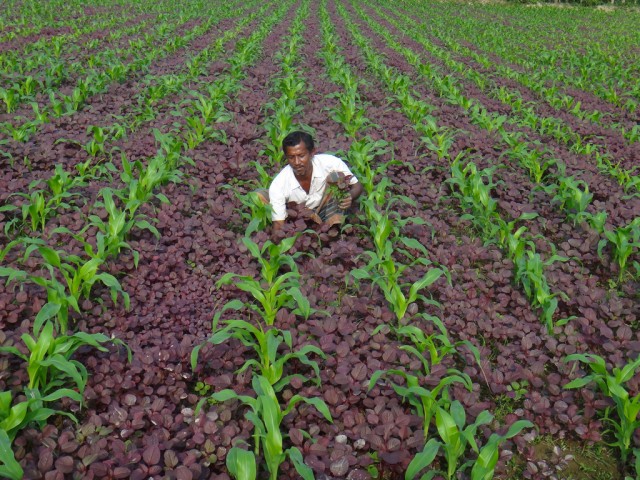intercropping
THE CULTIVATION OF TWO or more crops in combination in the same field at the same time is known as intercropping. This is one of two types of multiple cropping, the other being sequential cropping, whereby two or more crops are grown in sequence in the same field. There are four types of intercropping:
- Mixed intercropping is the cultivation of two or more crops that are randomly distributed rather than grown in rows. This practice is typical of slash-andburn agriculture, which relies on cutting and firing.
- Row intercropping involves the cultivation of different crops in adjacent rows. This is typical of agricultural systems with intermediate technology such as plows.
- Strip intercropping utilizes strips of land rather than narrow rows. Each strip is of sufficient magnitude that it can be cultivated independently, but the width does not preclude interaction between the crops, such as the prevention of disease as individual crops act as barriers. This practice is characteristic of commercial large-scale farming, which is mechanized.
- Relay intercropping involves the planting of a second crop into a first crop that is partway through its growth but is not yet ready for harvesting. It may incorporate elements of some of the above.

Where a tree crop is present, between the rows of which other crops or grass for fodder are grown, the system is referred to as agroforestry, but it is nevertheless a type of intercropping.
There are several advantages to intercropping that relate to socioeconomic factors and environmental factors. In an economic context, farmers practicing intercropping rarely experience total crop failure and so have a safety net provided by the successful crop(s). Farmers and their families may develop self-sufficiency when they cultivate crops for various purposes such as food, fiber, the feeding of animals and medicines. The practice also facilitates the spread of labor because intercropped species are planted, tended, and harvested at different times. Disadvantages are few but harvesting can be difficult if machinery or special skills are required for the different crops.
The ecological/environmental aspects of intercropping reflect the varied requirements of crop plants for nutrients, shade, light, length of growing season and disease resistance/susceptibility, as well as beneficial relationships with soil flora and fauna. It is, however, essential that an appropriate combination of species is selected. Overall, productivity increases per unit area of land in intercropped systems when compared with monocultural systems.
For example, it is advantageous to grow tall and short crop species—maize (corn) with peanuts or a root crop—especially those with different growing times, in alternate rows, as this reduces competition of light. Or two tall crops may be planted provided they have different growth rates so that they mature at different times. Leguminous crops are also important in intercropping systems because of their association with nitrogen-fixing bacteria that occupy root nodules. These fix nitrogen from the atmosphere and convert it into nitrates. Once in the soil, these salts benefit all crops and reduce or eliminate the need for costly artificial fertilizers.
An example of such an association for agriculture in a temperate environment is maize with oats and soybean, of which the latter is the legume. For a tropical environment, peanut is the legume that is intercropped with sorghum and millet.
Combinations of crops with different nutrient requirements are also desirable in order to utilize the nutrient store in the soil sustainably. In this respect, the crops complement each other and the agricultural system is similar to natural vegetation communities that tend to be diverse with the coexistence of species with complementary environmental requirements. Complementarity replaces competition.
Intercropping generally reduces the outbreak and impact of diseases and pests and so less of the produce is lost in the field. The crop variation appears to favor a wider variety of beneficial insects that prey on pests when compared with monoculture. Rows of crops not preferred by specific insects will act as barriers. Alfalfa, another legume, is especially beneficial in intercropping because it attracts more beneficial insects than most other crops. With careful management, pesticide use can be reduced. The spread of disease, such as fungal and viral pests, can also be limited by such barriers. The maintenance of a crop cover can reduce the incidence of weeds as can the establishment of a good root mat below ground if crops with different root systems are chosen.